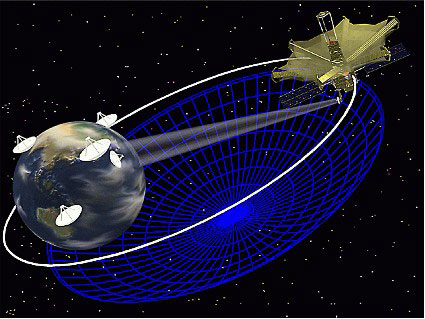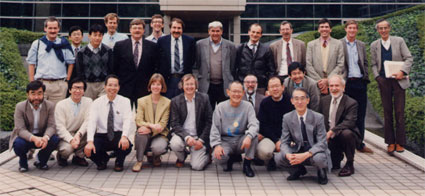TOP > Topics > 2005 > IAA Award to VSOP Team
![]()
IAA Award to VSOP Team
The International Academy of Astronautics (IAA) will award its annual Laurels for Team Achievement Award for 2005 to the VLBI (Very Long Baseline Interferometry) Space Observatory Programme (VSOP) Team. The award will be presented at the 56th International Astronautical Congress in Fukuoka, Japan, on October 16th. VSOP Project Manager, Prof. Hisashi Hirabayashi, will give a lecture entitled "Space VLBI, A Radio Telescope Bigger than the E" at the IAA Plenary Session.
The citation notes that the VLBI technique has enabled the longest astronomical wavelengths to be used to produce the highest angular resolution images. The VLBI Space Observatory Programme realized the long-held dream of radio-astronomers to extend those baselines into space, by observing celestial radio sources with the HALCA satellite, supported by a dedicated network of tracking stations, and arrays of ground radio telescopes from around the world. On behalf of the entire VSOP Team, the award highlighted the astronomers and engineers who made key contributions to realizing, and operating, a radio telescope bigger than the Earth:
(current Project Manager) Hisashi Hirabayashi (ISAS/JAXA),
(former Project Manager) Haruto Hirosawa (ISAS/JAXA),
Peter Dewdney (DRAO, Canada), Edward Fomalont (NRAO, USA),
Leonid Gurvits (JIVE, The Netherlands), Makoto Inoue (NAOJ),
David Jauncey (ATNF, Australia), Noriyuki Kawaguchi (NOAJ),
Hideyuki Kobayashi (NAOJ), Kazuo Miyoshi (MELCO),
Yasuhiro Murata (ISAS/JAXA), Takeshi Orii (NTS)
Robert Preston (JPL, USA), Jonathan Romney (NRAO, USA),
Joel Smith (JPL, USA).
The radio astronomy satellite HALCA was launched from Uchinoura, Kagoshima prefecture, on 12 February 1997 on the maiden flight of the ISAS M-V rocket. HALCA was placed in a highly elliptical 6.3 hour orbit, with an apogee height of 21,400 km above the Earth's surface. In VLBI observations, widely spaced radio telescopes simultaneously observe the same celestial radio source, digitize the radio signal, and record the data on magnetic tape. The tapes are later brought together at a correlator for the data to be combined. Simultaneous observations with HALCA's 8 meter diameter radio telescope and arrays of ground radio telescopes synthesize a radio telescope over twice the size of the Earth, enabling the highest angular resolution 1.6 GHz and 5 GHz images to be made.
VSOP is an international endeavor involving 25 radio telescopes from 14 countries, including ISAS's 64m antenna at Usuda, Nagano prefecture and the 34m telescope of NICT (formerly CRL) at Kashima. Five dedicated tracking stations were used for a two-way link to the satellite; a 10m ISAS antenna at Usuda, three NASA antennas in the USA, Spain and Australia, and a NRAO antenna in the USA. Data from the satellite and ground radio telescopes were combined at one of three correlation centers, at the Mitaka campus of NAOJ, at the Socorro NRAO site in the USA, and at the Penticton home of DRAO in Canada. Two orbit determination teams, one at ISAS and the other at JPL, provided the detailed solutions necessary for tracking the satellite and correlating the data. Mission operations were performed with close collaboration between ISAS and NAOJ, and with the assistance of international partners. An international advisory panel, the VSOP International Science Council, was established early in the mission to provide oversight and guidance for all aspects of the project.
HALCA has participated in over 780 VSOP observations, predominantly of the relativistic jets being ejected from the environment around supermassive black holes in active galactic nuclei. Two-thirds of VSOP observations have been made for observing projects selected by international peer-review from proposals submitted by the astronomical community in response to Announcements of Opportunity. The remainder have been devoted to the VSOP Survey Program, a mission-led systematic survey of active galactic nuclei at 5 GHz. VSOP images of unprecedented resolution at 1.6 and 5 GHz are of fundamental importance to on-going efforts to understand the physical nature of strong, compact radio sources. In particular, the VSOP project has helped to understand the process of relativistic ejections from the environment around super-massive black holes in active galactic nuclei --- the most energetic power-houses of the Universe.
The VSOP mission is nearing its end, however, planning for a next generation mission, "VSOP-2", is well underway. VSOP-2 will provide ten times better angular resolution, ten times better sensitivity, and shorter observing wavelengths than VSOP.
The unique technical achievements of the VSOP mission have included the deployment in orbit of the 8 m antenna, the round-trip phase transfer from ground-based frequency standards to the spacecraft, real-time down-link of the broad-band science data from the satellite at 128 megabits per second, and precise orbit determination. ISAS shared with Mitsubishi Electric Corporation the 1998 Japan Society for the Promotion of Machine Industry Prize for the design, manufacture and deployment of HALCA's main reflector. The Institute of Electronics, Information and Communication Engineers presented Profs. Hirosawa and Hirabayashi with an Award for Excellent Achievement for "Development of the Radio-astronomy Satellite HALCA and the Realization of Space-VLBI" in 2002.
The Laurels for Team Achievement Award was created in 2001 to recognize extraordinary performance and achievement by a team of scientists, engineers and managers in the field of Astronautics. The previous recipients are the Russian Mir Space Station Team (2001), the US Space Shuttle Team (2002), the Solar and Heliospheric Observatory (SOHO) Team (2003), and the Hubble Space Telescope Team (2004).
The International Academy of Astronautics was founded in August 1960 in Stockholm, Sweden, during the 11th International Astronautical Congress. The Academy aims to foster the development of astronautics for peaceful purposes; recognize individuals who have distinguished themselves in a related branch of science or technology; provide a program through which members may contribute to international endeavors; cooperation in the advancement of aerospace science.
For more details about the VSOP mission see the web pages
 http://www.vsop.isas.jaxa.jp (in English)
http://www.vsop.isas.jaxa.jp (in English)
 http://wwwj.vsop.isas.jaxa.jp (in Japanese)
http://wwwj.vsop.isas.jaxa.jp (in Japanese)
For more details about HALCA see the web pages
http://www.isas.jaxa.jp/e/enterp/missions/halca/
For more details about the International Academy of Astronautics see
 http://www.iaanet.org/
http://www.iaanet.org/
and for previous recipients of the Laurels for Team Achievment Award see
 http://www.iaanet.org/awards/laurels.html
http://www.iaanet.org/awards/laurels.html
The HALCA satellite, co-observing with ground radio telescopes, and using a real-time, two-way, link to a dedicated tracking station, to synthesize a radio telescope bigger than the earth. |
Members of the international VSOP team, including 12 of the recipients of the IAA award, pictured at ISAS circa 1995. |
October 14, 2005






